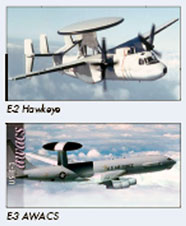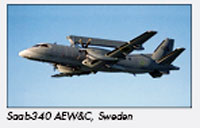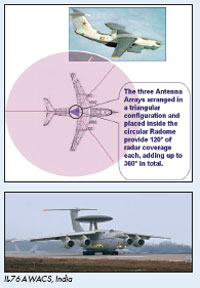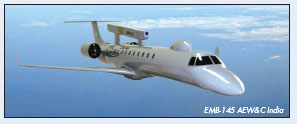|
In today’s air warfare, the Airborne
Early Warning and Control (AEW&C) aircraft will
detect, identify and classify hostile intruders
and then, acting as a Command & Control Centre,
will employ its air defence forces to neutralize
the threats to Nation’s assets.
AN ‘EYE’ IN THE SKY
The significant inventions of the early 20th
century, viz., the aircraft and the RADAR, led
to the clever combination of the two technologies
giving birth to a distinctly identified ‘Air-borne
Early Warning and Control’ (AEW&C) concept, thus
re-writing the tactics for today’s air-warfare.
The roles that the two dominant AEW&C systems,
viz., the E-2C Hawkeye and the E-3 AWACS played
during the Gulf War (1991) amply illustrate the
power of these systems. During Operation Desert
Shield and Desert Storm, the AEW&C aircraft helped
overcome surveillance deficiencies and conduct
successful air operations. They assisted the fighter
fleet by providing early threat detection and
building up situational awareness that led to
39 out of 41 air-to-air engagements being successful.
The AEW&C system soon proved itself to be
a dominant Force Multiplier with its abilities
to execute multiple functions - Surveillance,
Early Warning, Electronic Intelligence, Communication
Intel l igence, Command and Control tasks, Battle
Management, etc. – all from a single airborne
platform. The AEW&C systems effectively impacted
the dynamics of air warfare and irreversibly changed
its nature.
ELECTRONICALLY STEERED
ARRAY RADAR
 Both
E-2C Hawkeye and E-3 AWACS aircraft carried mechanically
steered antenna (MSA) in a rotating dome to scan
the sky. In the early 1990s, a more versatile
breed of AEW&C systems with Electronically Steered
Array radar started making their appearance progressively. Both
E-2C Hawkeye and E-3 AWACS aircraft carried mechanically
steered antenna (MSA) in a rotating dome to scan
the sky. In the early 1990s, a more versatile
breed of AEW&C systems with Electronically Steered
Array radar started making their appearance progressively.
The AESA is mounted in a fixed position on the
aircraft structure and the beam is steered by
individually controlling the phase of the radio
waves transmitted and received by each of the
multiple radiating elements in the antenna.
The inherent advantages of the AESA radar are
the obvious ‘inertia less scanning’ and the ‘minimal
feeder loss’ as no lengthy feeder cables are involved.
Unlike in the Mechanically Scanned Array (MSA)
Radar, the AESA Radar has the impudence to perform
even with failure of some of its radiating elements.
The AESA radar goes through a graceful degradation
with cumulative failures in its battery of Transmit-Receive
modules. The AESA Radar helps build substantially
more compact radar systems resulting in low weight,
minimal aerodynamic drag and relatively smaller
Radar Cross Section (RCS), all of which are operationally
of vital importance for the platform aircraft.
Besides, the AESA radar provides enhanced beam
agility with higher reliability. The latest AESA
sensor further helps track air- and sea- targets
simultaneously as well as tracks continuously
the high-performance aircraft, while maintaining
the routine scan over the operational area.
SAAB-340 AEW&C
 The
world’s first of the AEW&C systems to sport AESA
radar was the Swedish Saab-340 AEW&C aircraft.
The Saab-340 is a twin-engine turboprop aircraft.
An AEW version with phased-array radar, Erieye,
in a rectangular pod on top of the fuselage was
delivered in 1994. The Swedish Air Force ordered
for six units of the aircraft. Some numbers are
used by Japan as Search-and- Rescue aircraft.
A recent variant of Saab-340 AEW&C, designated
Saab-2000 AEW&C, using the same Erieye AESA radar,
has been ordered by Pakistan. The
world’s first of the AEW&C systems to sport AESA
radar was the Swedish Saab-340 AEW&C aircraft.
The Saab-340 is a twin-engine turboprop aircraft.
An AEW version with phased-array radar, Erieye,
in a rectangular pod on top of the fuselage was
delivered in 1994. The Swedish Air Force ordered
for six units of the aircraft. Some numbers are
used by Japan as Search-and- Rescue aircraft.
A recent variant of Saab-340 AEW&C, designated
Saab-2000 AEW&C, using the same Erieye AESA radar,
has been ordered by Pakistan.
The Ericsson Erieye radar uses an active array
with 200 solid state modules. The antenna is housed
in a 9m long box radome mounted atop thet fuselage.
The look angle on each side of the radome is about
120 degrees in the azimuth. Since the surveillance
is on the sides, azimuth coverage of 120 degrees
is not a limitation and the practice has been
there for over a decade.
The electronically scanned antenna can scan sectors
of interest frequently while others are monitored;
and a single sector can be scanned in different
modes at the same time. The aircraft functions
as an airborne radar integrated with the total
air defence network.
 EMB-145
AEW&C EMB-145
AEW&C
Brazil saw the virtue of the Ericsson Erieye
radar of the Saab-340 AEW&C and chose to mount
the same on its bigger and faster twin-engine
regional jet aircraft, EMB-145. The endurance
of this system is about six hours.
M/s Embraer of Brazil built the EMB-145 AEW&C
aircraft for Air Forces of Brazil, Mexico and
Greece with the Erieye radar and other subsystems
as opted by the user Air Forces. These subsystems
include radar, Identification Friend or Foe, Communication
Support Measures, Electronic Support Measures,
and Data/Voice Communications.
 G-550
CAEW G-550
CAEW
In the year 2001, M/s ELTA of Israel started
work on a Conformal Airborne Early Warning aircraft
based on the Gulfstream G-550. This system, called
the G-550 CAEW, includes phased array radar, phased
array IFF, Signal Intelligence (SIGINT), and a
communications system. The communications system
includes a data-link and satellite communication
(SATCOM) system for secure high-speed connectivity
with ground stations. The ELTA radar conformally
built on the sides of the fuselage works on the
‘L’-Band and provides coverage on the LH and RH
sides. In the forward and aft directions, independent
radars mounted on the nose and tail of the aircraft
work on the ‘S’-Band and provide radar coverage
of relatively reduced range. Consequently, total
azimuth coverage is effectively only for 240 degrees
and the rest of the azimuth coverage is limited
in range. The G-550 CAEW is now ready and on order
for Israel and Singapore.
The endurance of this system is about eight hours.
 B-737
AEW&C, WEDGETAIL B-737
AEW&C, WEDGETAIL
The Boeing Company is building for the Royal
Australian Air Force (RAAF) an AEW&C system designated
B-737 AEW&C, Wedgetail. The Boeing AEW&C Solution
combines the new Boeing 737-700 aircraft with
the Northrop Grumman Multirole Electronically
Scanned Array (MESA) radar. Included in the platform
are an Identification Friend or Foe (IFF) system;
an expanded, passive electronic surveillance system;
and an effective selfdefence capability.
Northrop Grumman’s MESA radar is mounted in a
rectangular ‘T’- structure atop the fuselage providing
for 240-degrees full range coverage and for the
rest of the azimuth angle partial range coverage.
The cabin houses six Mission Operator Consoles.
The radar can track air and sea targets simultaneously
and can help the operator track high-performance
aircraft while continuously scanning the operational
area. The endurance of this system is about eight
hours.
The 737 AEW&C platform, with its interoperability
with the E-3 and B-767 AWACS aircraft, is designed
to fill the airborne-surveillance needs of Australia.
The first of the six planes ordered by the RAAF
is due to be delivered in 2010. Turkey has also
ordered for a few numbers of the B-737 AEW&C.
 IL-76
AWACS IL-76
AWACS
Israel and Russia are jointly developing an
AWACS system for Indian Air Force with true 360°
azimuth coverage radar built into the Russian
Briev IL-76 aircraft platform. This system is
built around an AESA ‘L’-band radar, and adds
electronic and communications intelligence gathering
(ELINT and COMINT) capabilities. The system is
interoperable with other air and ground stations,
and uses sensor fusion to provide a complete picture
of the battle space.
India’s IL-76 AWACS will use a conventional circular
radome mounted on top of its fuselage. The radome
will, however, be fixed and not rotating. The
ELTA radar, with a set of three phased-arrays
housed in a triangular configuration inside the
radome, will operate in ‘L’-Band and scan 360
degrees in the azimuth. The endurance of this
system is about seven hours.
Delivery of the first IL-76 AWACS system to Indian
Air Force is slated to be in mid 2009 and completed
by the year 2011.
THE INDIGENOUS AEW&C SYSTEM
The Defence Research and Development Organisation
(DRDO) have launched an Indigenous AEW&C programme
that is focussed on specific needs of the Indian
Air Force. The Centre for Air-Borne Systems (CABS)
of the DRDO is tasked with the development of
the system and the centre is pursuing the programme
with participation of multiple workcentres from
within DRDO as well as Indian industries in the
Public and Private Sector.
The Indian AEW&C system is at par in respect
of functionalities with any of the modern AWACS/AEW&C
systems in the world.
The Indian AEW&C system to be integrated on to
an Embraer EMB- 145 Regional Jet class of aircraft
will detect, identify and classify threats present
in the surveillance area and act as a Command
and Control Centre to support Air Defence operations.
The system with its multiple Communication and
Data Links can alert and direct fighters against
threats while providing ‘Recognizable Air Situation
Picture’ to commanders at the Ground Exploitation
Stations that are strategically located. The AEW&C
system can thus support Air Force in offensive
strike missions and assist Forces in the tactical
battle area. Besides, the Electronic and Communication
Support Measures of the system can intercept and
counter unfriendly radar transmissions and communication
signals.
 The
primary sensor for the AEW&C will be the indigenous
AESA “S”-Band radar with adequate detection range
against targets of the fighter class of aircraft.
Two radiating planar arrays assembled back-to-back
and mounted on top of the fuselage in an Active
Antenna Array Unit (AAAU) will provide nearly
150° coverage on either side of the AAAU. The
important modes of operation of the system are
the surface surveillance and the air surveillance. The
primary sensor for the AEW&C will be the indigenous
AESA “S”-Band radar with adequate detection range
against targets of the fighter class of aircraft.
Two radiating planar arrays assembled back-to-back
and mounted on top of the fuselage in an Active
Antenna Array Unit (AAAU) will provide nearly
150° coverage on either side of the AAAU. The
important modes of operation of the system are
the surface surveillance and the air surveillance.
The sensor has the abilities to search, track
while scan, priority tracking, high performance
tracking, etc. In priority tracking, the targets
will be placed in full track mode even if they
cross the primary surveillance area. In high performance
tracking, additional measurements will be made
to improve the tracking accuracies. Utilising
the active aperture technology, the radar provides
a fastbeam agile system that can operate in several
modes concurrently. Interoperability with AWACS,
other AEW&C aircraft, fighters and Ground Exploitation
Stations is ensured using data-links with voice
and data channels.
The endurance of nine hours with one Air-to-Air
Refuelling.
The aircraft cabin houses five Operator Work
Stations to adequately meet requirements of the
operational mission tasks. An Air-to-Air Refuelling
system enables extended operations at times of
need. The system is expected to be available in
2012.
CONCLUSION
It is evident that most of the modern AWACS/AEW&C
systems using Active Electronically Steered Array
Radar are yet to be in the market with the exception
of Saab-340/EMB-145 with Ericsson’s Erieye radar.
The total cost of an AWACS/AEW&C system is determined
by the Procurement Cost and the Life-cycle Cost.
The Indian AEW&C system will have, for known reasons,
a price advantage in the international market.
Considerable thought has gone into arriving at
the configuration design of the Indigenous EMB-
145 AEW&C system to make the EMB-145 platform
aircraft and the AEW&C Mission System a win-win
combination to realise a compact and optimal surveillance
system that meets the Air Force’s requirements
fully and cost-effectively. When the EMB-145 AEW&C
India takes to the air in 2012, it will be one
among the select breed of Watchdogs of the Skies.
Dr S Christopher is Director,
Centre for Air-borne Systems, Defence Research
& Development Organisation, Bangalore.
|